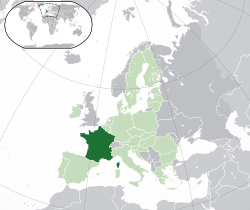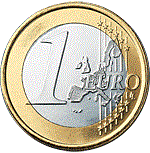
There are eight euro coin denominations, ranging from one cent to two euros. The coins first came into use in 2002. They have a common reverse, portraying a map of Europe, but each country in the eurozone has its own design on the obverse, which means that each coin has a variety of different designs in circulation at once. Four European microstates that are not members of the European Union use the euro as their currency and also have the right to mint coins with their own designs on the obverse side.
Belgian euro coins feature only a single design for all eight coins: the portrait or effigy of the King of the Belgians. Previously, all Belgian euros depicted King Albert II and his royal monogram. Current coins depict King Philippe. Also part of the design by Jan Alfons Keustermans are the 12 stars of the EU and the year of imprint.
Greek euro coins feature a unique design for each of the eight coins. They were all designed by Georgios Stamatopoulos with the minor coins depicting Greek ships, the middle ones portraying famous Greeks and the two large denominations showing images of Greek history and mythology. All designs feature the 12 stars of the EU, the year of imprint and a tiny symbol of the Bank of Greece. Uniquely, the value of the coins is expressed on the national side in the Greek alphabet, as well as being on the common side in the Roman alphabet. The euro cent is known as the lepto in Greek, a name which has also been used for the 1⁄100 denominations of the preceding currencies of the Greek state, the phoenix and drachma.

The Napoléon is the colloquial term for a former French gold coin. The coins were minted in denominations of 5, 10, 20, 40, 50, and 100 francs. This article focuses on the 20 franc coins issued during the reign of Napoléon Bonaparte, which are 21 mm in diameter, weigh 6.45 grams and, at 90% pure, contain 0.1867 troy ounces (5.807 g) of pure gold. The coin was issued during the reign of Napoleon I and features his portrait on the obverse. The denomination continued in use through the 19th century and later French gold coins in the same denomination were generally referred to as "Napoléons". Earlier French gold coins are referred to as Louis or écu. Gold Napoléons have historically proven more resilient than other gold coins to economic forces, such as after the Suez crisis when unlike other coins Napoléons did not weaken.

The Royal Canadian Mint is the mint of Canada and a Crown corporation, operating under the Royal Canadian Mint Act. The shares of the Mint are held in trust for the Crown in right of Canada.

A mint is an industrial facility which manufactures coins that can be used as currency.

The franc, also commonly distinguished as the French franc (FF), was a currency of France. Between 1360 and 1641, it was the name of coins worth 1 livre tournois and it remained in common parlance as a term for this amount of money. It was reintroduced in 1795. After two centuries of inflation, it was redenominated in 1960, with each new franc (NF) being worth 100 old francs. The NF designation was continued for a few years before the currency returned to being simply the franc. Many French residents, though, continued to quote prices of especially expensive items in terms of the old franc, up to and even after the introduction of the euro in 2002. The French franc was a commonly held international reserve currency of reference in the 19th and 20th centuries. Between 1998 and 2002, the conversion of francs to euros was carried out at a rate of 6.55957 francs to 1 euro.
This glossary of numismatics is a list of definitions of terms and concepts relevant to numismatics and coin collecting, as well as sub-fields and related disciplines, with concise explanations for the beginner or professional.
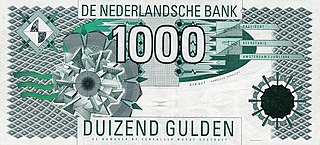
The guilder or florin was the currency of the Netherlands from 1434 until 2002, when it was replaced by the euro.

The 1 euro coin (€1) is a euro coin with a value of one euro. It is made of two alloys: the inner part of cupronickel, the outer part of nickel brass. All coins have a common reverse side and country-specific national sides. The coin has been used since 2002, with the present common side design dating from 2007.
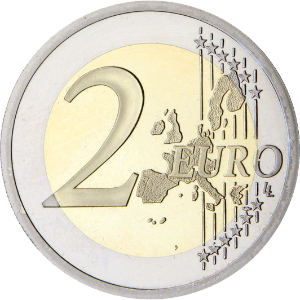
The 2 euro coin (€2) is the highest-value euro coin and has been used since the introduction of the euro in 2002. The coin is used in 22 countries with a collective population of about 341 million. The coin is made of two alloys: the inner part of nickel brass, the outer part of copper-nickel. All coins have a common reverse side and country-specific national sides. The coin has been used since 2002, with the present common side design dating from 2007.
Before the introduction of the euro, the current eurozone members issued their own individual national coinage, most of which featured mint marks, privy marks and/or mint master marks. These marks have been continued as a part of the national designs of the euro coins, as well. This article serves to list the information about the various types of identifying marks on euro coins, including engraver and designer initials and the unique edge inscriptions found on the €2 coins.
France has a rich selection of gold and silver commemorative coins. These coins are minted by Monnaie de Paris, which is a state owned industrial and commercial company.
France has a rich selection of Gold and Silver commemorative coins. These coins are minted by Monnaie de Paris, which is a state owned industrial and commercial company.
France has a rich selection of Gold and Silver commemorative coins. These coins are minted by Monnaie de Paris, which is a state owned industrial and commercial company.
France has a rich selection of Gold and Silver commemorative coins. These coins are minted by Monnaie de Paris, which is a state owned industrial and commercial company.
France has a rich selection of Gold and Silver commemorative coins. These coins are minted by Monnaie de Paris, which is a state owned industrial and commercial company.

Euro gold and silver commemorative coins are special euro coins minted and issued by member states of the Eurozone, mainly in gold and silver, although other precious metals are also used in rare occasions. Monaco was one of the first countries allowed to introduced the euro (€) on 1 January 2002, although they are not officially part of the Eurozone. Since then, the Monnaie de Paris in France have been minting both normal issues of Monégasque euro coins, which are intended for circulation, and commemorative euro coins in gold and silver.
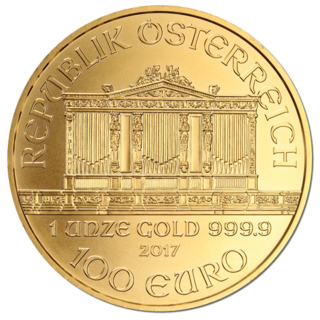
The Vienna Philharmonic, often shortened to Philharmonic, is a bullion coin of gold, silver, or platinum produced by the Austrian Mint. The coin is named for the Vienna Philharmonic orchestra, which inspired the design of both sides. It was introduced in 1989 as a one-troy ounce (ozt), gold coin with a face value of 2,000 Austrian schillings. It is generally one of the world's best selling bullion coins. In 2002, with the adoption of the euro currency, the nominal value of the one-ounce coin was changed to 100 euros. In 2008, the Mint introduced a one-ounce silver version of the coin with a nominal value of 1.50 euros. The silver coin is also one of the top selling bullion coins, ranked third in 2013. In 2016, the mint introduced a one ounce platinum coin with a face value of 100 euros.
